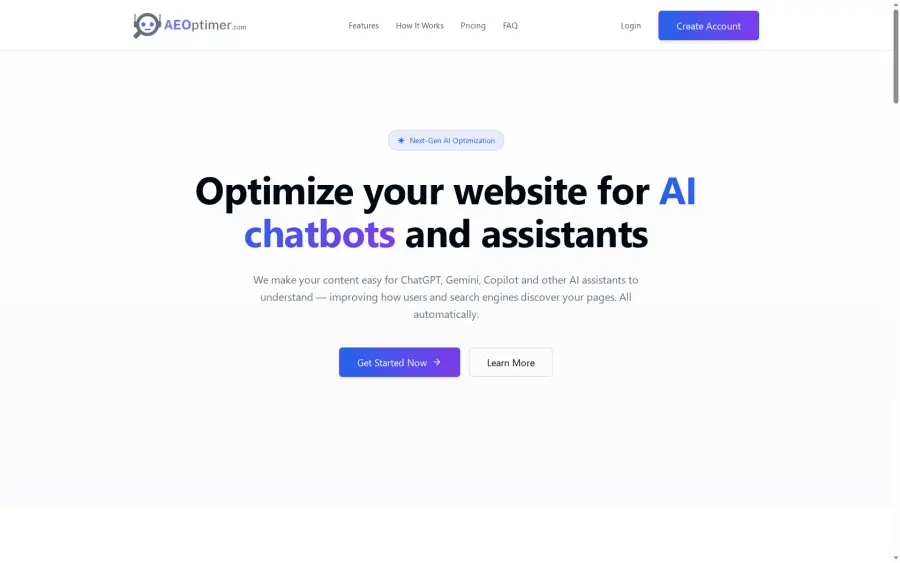Complete Guide to Why Websites Need Optimization

Most websites lose nearly 40 percent of visitors if pages load too slowly or offer a confusing experience. In a digital world shaped by rapid searches and AI tools, how your site performs and appears directly shapes who finds you and who stays. Understanding website optimization means unlocking better speed, visibility, and engagement—giving your business a real edge where it matters most.
Table of Contents
- Defining Website Optimization And Its Purpose
- Types Of Website Optimization Methods
- How Optimization Impacts Seo And Ai Discoverability
- Automation, Structured Data, And Content Updates
- Risks Of Poor Optimization And Common Pitfalls
Key Takeaways
| Point | Details |
|---|---|
| Website Optimization Importance | Website optimization is essential for improving digital performance and visibility, driving user engagement, and sustaining competitive advantage. |
| Core Optimization Components | Key strategies include technical performance improvements, content quality enhancement, structured data implementation, and mobile responsiveness. |
| SEO and AI Discoverability | Optimization tactics must adapt for AI and advanced search algorithms, focusing on machine-readable content and metadata for enhanced visibility. |
| Risks of Poor Optimization | Suboptimal website performance can lead to decreased user satisfaction, lower search rankings, and reduced AI discoverability, jeopardizing digital success. |
Defining Website Optimization and Its Purpose
Website optimization represents a strategic approach to enhancing digital performance and visibility across search platforms and AI discovery tools. According to Wikipedia, web performance fundamentally refers to the speed at which web pages are downloaded and displayed on a user’s browser, with optimization techniques designed to improve this critical metric.
At its core, website optimization involves a comprehensive set of technical and content-driven strategies aimed at improving how websites function, appear, and perform across multiple digital environments. These strategies encompass multiple dimensions including page loading speed, search engine ranking, user experience, and AI discoverability. MECS Press highlights that well-designed websites utilizing advanced optimization techniques can help businesses survive in competitive markets by dramatically improving website visibility and user engagement.
Key components of effective website optimization typically include:
- Technical Performance: Reducing page load times
- Content Quality: Creating relevant, valuable content
- Structured Data: Implementing schema markup for better AI understanding
- Mobile Responsiveness: Ensuring seamless experience across devices
- Search Engine Compatibility: Aligning with current SEO best practices
Beyond these technical considerations, modern website optimization recognizes the growing importance of AI-driven discovery platforms. Websites must now be engineered not just for human readers, but for intelligent systems that crawl, analyze, and interpret digital content. This means creating clear, structured, semantically rich content that machines can easily comprehend and contextualize.
For businesses and website owners, optimization is no longer optional—it’s a critical strategy for digital survival. By systematically improving website performance, content clarity, and technical infrastructure, organizations can significantly enhance their online visibility, user engagement, and ultimately, their digital success.
 Enhance your website’s optimization potential with our comprehensive guide on web page optimization.
Enhance your website’s optimization potential with our comprehensive guide on web page optimization.
Types of Website Optimization Methods
Website optimization encompasses multiple strategic approaches designed to enhance digital performance and visibility. According to IJSRCSEIT, search engine optimization techniques include several key methods such as website optimization, keyword optimization, link optimization, and website submission, all aimed at improving a site’s visibility and ranking in search results.
The most critical types of website optimization methods can be categorized into several core domains:
Here’s a comparison of core website optimization methods:
| Optimization Method | Key Techniques | Primary Benefits |
|---|---|---|
| Search Engine Optimization (SEO) | Technical SEO Keyword implementation Link building |
Higher search ranking Increased organic traffic |
| Performance Optimization | Page speed enhancement Image compression Mobile responsiveness |
Faster load times Improved user experience |
| Content Optimization | High-quality content Semantic markup AI-friendly data |
Better engagement Enhanced discoverability |
- Search Engine Optimization (SEO)
- Technical SEO improvements
- Content optimization
- Keyword research and implementation
- Link building strategies
- Performance Optimization
- Page load speed enhancement
- Mobile responsiveness
- Server response time reduction
- Image and resource compression
- Content Optimization
- Creating high-quality, relevant content
- Implementing semantic markup
- Ensuring content readability
- Developing AI-friendly structured data
Arxiv highlights the importance of multivariate optimization, which involves systematically testing various combinations of webpage elements to determine the most effective layout for enhancing user engagement and conversion rates. This approach allows website owners to make data-driven design and content decisions.
Modern optimization strategies extend beyond traditional techniques, recognizing the growing importance of AI-driven platforms. Websites must now be engineered to serve both human users and intelligent systems that crawl, analyze, and interpret digital content. This holistic approach ensures maximum visibility, engagement, and performance across multiple digital ecosystems.
Learn more about advanced page optimization techniques in our comprehensive guide.
How Optimization Impacts SEO and AI Discoverability
Website optimization has become increasingly critical in an era dominated by sophisticated search algorithms and AI-driven discovery platforms. Wikipedia introduces the concept of Generative Engine Optimization (GEO), which focuses on adapting digital content to improve visibility in results produced by generative artificial intelligence, fundamentally changing how AI models retrieve and present information.
The intersection of SEO and AI discoverability reveals several key strategic dimensions:
- Content Semantic Structure: Creating machine-readable content
- Metadata Optimization: Enhancing AI comprehension signals
- Contextual Relevance: Developing content that answers specific queries
- Technical Markup: Implementing schema and structured data
- User Intent Alignment: Matching content with potential AI search patterns
Traditional SEO techniques are evolving to meet the complex requirements of intelligent search systems. Wikipedia highlights progressive enhancement as a critical web design strategy that emphasizes content first, ensuring basic functionality while providing enhanced features for advanced platforms. This approach not only improves accessibility but also increases the likelihood of AI systems accurately interpreting and presenting website content.
Modern optimization strategies must now consider how AI platforms like ChatGPT, Gemini, and Copilot interpret and contextualize digital information. Websites need to be structured with clear, concise, and semantically rich content that can be easily parsed by both human readers and intelligent systems. By focusing on clear communication, structured data, and comprehensive topic coverage, websites can significantly improve their chances of being prominently featured in AI-generated search results and recommendations. Learn more about AI website optimization strategies in our comprehensive guide.
Automation, Structured Data, and Content Updates
Website automation represents a transformative approach to maintaining digital relevance in an increasingly complex online ecosystem. Arxiv highlights the potential of utilizing server logs to analyze user behavior, which can inform automated improvements to a website’s hyperlink structure, ultimately enhancing navigation and overall user experience.
Key components of modern automated website optimization include:
- Continuous Content Analysis
- Intelligent Metadata Management
- Adaptive Structural Updates
- Performance Monitoring
- AI-Driven Content Recommendations
Structured data plays a critical role in enabling intelligent automation. By implementing comprehensive schema markup, websites can provide explicit signals to AI and search platforms about their content’s context, meaning, and relevance. This approach transforms static web pages into dynamic, machine-readable information repositories that can be easily interpreted and indexed by advanced algorithms.
The integration of automated systems allows websites to maintain perpetual optimization without constant manual intervention. Wikipedia suggests the importance of targeting different data samples and comparative analysis, a principle that translates directly into sophisticated content update strategies. Modern optimization platforms can automatically detect content gaps, recommend updates, and even implement changes that align with current search trends and AI discovery requirements. Explore our comprehensive guide on monthly website optimization steps for AI discoverability.
Risks of Poor Optimization and Common Pitfalls
Website optimization is not just a technical enhancement but a critical business strategy. Wikipedia warns that poor web performance can dramatically decrease visitor retention and user satisfaction, especially for users with slow internet connections or those accessing websites through mobile devices.
Common optimization pitfalls that can severely impact digital performance include:
- Slow Page Load Times
- Non-Responsive Design
- Inadequate Mobile Compatibility
- Complex Navigation Structures
- Inconsistent Content Quality
- Poor Metadata Implementation
Neglecting comprehensive optimization strategies can lead to significant digital disadvantages. Wikipedia highlights that overlooking progressive enhancement can render websites inaccessible to users with limited browser capabilities, potentially causing substantial audience loss. This means businesses might inadvertently create digital barriers that prevent potential customers from engaging with their content.
The consequences of poor optimization extend beyond immediate user experience. Websites with suboptimal performance risk lower search engine rankings, reduced AI discoverability, and diminished credibility in an increasingly competitive digital landscape.
INFOGRAPHIC:infographic_content] Search algorithms and AI platforms prioritize well-structured, fast-loading, and content-rich websites, making optimization not just a recommendation but a necessity for digital survival. [Discover our comprehensive guide to avoiding website optimization pitfalls.
Take Control of Your Website Optimization Journey Today
The article clearly highlights the challenges of maintaining high website performance, ensuring seamless AI discoverability, and implementing structured data without demanding technical expertise. If you feel overwhelmed by slow page loads, poor mobile responsiveness, or the constant pressure to keep up with evolving AI and search engine standards you are not alone. Many website owners share the same pain points like the fear of losing search rankings and missing out on AI-generated traffic.
aeoptimer.com offers a smart solution to these exact problems by automating the entire optimization process. Our platform adds AI-friendly content enhancements and essential structured data while keeping your site visually intact. Without any complicated coding you can enable monthly automatic crawls and updates that sync with the latest SEO and AI trends.

Don’t wait until poor optimization costs you visitors and revenue. Visit aeoptimer.com now to start enhancing your website’s visibility to AI assistants like ChatGPT and Gemini. Explore how automatic sitemap detection and continuous content updates can keep you ahead in the fast-changing digital landscape. Take immediate action and secure your website’s success with advanced page optimization techniques tailored to your needs.
Frequently Asked Questions
What is website optimization and why is it important?
Website optimization refers to the process of enhancing a website’s digital performance and visibility across search platforms and AI discovery tools. It’s important because optimized websites load faster, rank higher in search results, and provide a better user experience, which ultimately leads to increased engagement and conversions.
What are the key components of effective website optimization?
Key components include technical performance (like improving page load times), content quality (creating relevant and valuable content), structured data (implementing schema markup), mobile responsiveness, and search engine compatibility (adhering to SEO best practices).
How does website optimization impact SEO and AI discoverability?
Website optimization improves SEO by enhancing content structure, metadata, and user intent alignment, leading to higher search rankings. Additionally, it ensures that websites are better understood by AI systems, increasing visibility in AI-generated search results and recommendations.
What are common pitfalls in website optimization?
Common pitfalls include slow page load times, non-responsive design, inadequate mobile compatibility, complex navigation, and poor metadata implementation. These issues can lead to decreased visitor retention, lower search engine rankings, and reduced AI discoverability.
Recommended
- Web Page Optimization Explained: Enhance Search and AI | AEOptimer.com
- What Is Page Optimization? Complete Guide to Success | AEOptimer.com
- Why AI Optimized Websites: Complete Guide 2024 | AEOptimer.com
- 7 Clear Examples of Search Engine Optimization for Sites | AEOptimer.com
- Website Performance Impact: How Speed and UX Drive Results





